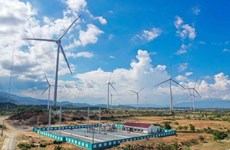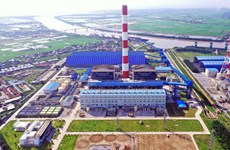Building AEC in the mind of Vietnam and Malaysia
Vietnam Economic News talked with Malaysian Trade Commissioner in Ho Chi
Minh City Ahmad Shanizam Abd. Ghani about the benefit of the ASEAN
Economic Community (AEC) to Vietnam and Malaysia.
Vietnam Economic News talked with Malaysian Trade Commissioner in Ho Chi
Minh City Ahmad Shanizam Abd. Ghani about the benefit of the ASEAN
Economic Community (AEC) to Vietnam and Malaysia.
* Why is the AEC beneficial to Malaysia and Vietnam?
The AEC marked the commitment of ASEAN leaders to build and promote a single market and production base, a highly competitive economic region tempered with equitable development, and a region fully integrated into the global economy. It cannot be denied that the implementation of the AEC has benefitted the people in the region through increased per capita income and expansion in both intra-ASEAN and extra-ASEAN trade and investment flows.
The per capita income in the region had increased to 3,579 USD in 2012. The total trade of ASEAN grew by 16.8 percent from 2.05 trillion USD in 2010 to 2.47 trillion USD in 2012. Intra-ASEAN trade represented 26 percent of total ASEAN trade or 601 billion USD. ASEAN also continued to attract foreign investors, generating a record 108 billion USD inflow in 2012.
In face of stiff economic competition with the rise of new economic powers such as Brazil, Russia, India, China and South Africa, the deepening of economic integration is the only way forward. Failing to do so will lead to diminishing ASEAN’s attractiveness as an investment location and its position as an economic powerhouse in the Asian region.
Individually, ASEAN member states have small populations and market bases and as such simply cannot compete against larger countries that employ a similar export oriented development strategy. By combining efforts, however, ASEAN member states may gain a larger platform for trade and investments, the free movement of talents along with the diffusion of technology, which are essential elements to continued economic growth.
Collectively, Malaysia and Vietnam with a population of 120 million people account for close to 20 percent of total ASEAN population. Thus, both countries in particular will gain much from the AEC. Under the AEC, Malaysia has eliminated import duties on all products except for alcoholic beverages, rice and some tropical fruits. Vietnam will eliminate duties by 2015. Thus, Malaysian market is relatively open to imports.
* Malaysia and Vietnam are joining Trans-Pacific Partnership (TPP) and Regional Comprehensive Economic Partnership (RCEP) negotiations. What are your views on trade and investment opportunities for the two countries?
The Regional Comprehensive Economic Partnership or ASEAN+6 FTA also aims to achieve a high-quality and mutually beneficial economic partnership agreement that will broaden and deepen current ASEAN+1 FTA engagements. It is expected to be concluded by the end of 2015. Malaysia and Vietnam, as a member of the ASEAN+1 FTAs, are already implementing the various commitments through liberalization of import tariffs, services and investment.
The RCEP is not a bloc aimed at competing with the ongoing negotiations under TPP Agreement. Four ASEAN member states - Malaysia, Singapore, Brunei and Vietnam - are in both TPP and RCEP negotiations. In 2015, the ASEAN Economic Community will be realised and the RCEP which strengthens linkages with the major trading nations in Asia will further boost the ASEAN’s global competitiveness.
As Malaysia and Vietnam are members to ASEAN and TPPA, Malaysia and Vietnam foresee that bilateral trade between both countries will increase significantly once AEC 2015 is realised and the TPPA is implemented. The global economic challenges called for both countries to form more collaboration in areas such as oil and gas, power and agriculture that will assist in deflecting the negative impact on both countries’ economy. The scope for expanding trade is extremely good. However, we need to enhance awareness of opportunities for businesses in both countries. Malaysia has been embarking on regular trade and investment missions to Vietnam. We will continue to do so. We also have the Malaysia-Vietnam Joint Trade Committee chaired by our Trade Ministers. In terms of connectivity we have over 80 flights weekly between Malaysia and Vietnam, and this is expected to further increase as our economic engagement expands.
I am encouraged to see that Vietnam is also doing the same. This year in May, we had the Vice President of Vietnam leading a business delegation to Malaysia. On October 11-12, 2013, we had a Malaysia-Vietnam Economic Forum in Kuala Lumpur. The forum was held in conjunction with the visit of H.E. Hoang Trung Hai, Deputy Prime Minister of Vietnam, to attend the Global Entrepreneurship Summit 2013 in Malaysia.
The forum was attended by 21 Malaysian companies and 14 business associations. The participants were briefed on the status of Malaysia-Vietnam bilateral relations, Vietnam’s current economic situation, initiatives implemented under Vietnam’s economic reform, and opportunities for investing in Vietnam. It was also highlighted that Malaysia’s involvement in three power plant projects in Vietnam including the Toyo Ink Group Bhd’s 2,000MW Song Hau 2 coal-fired power plant, the C.H.E Company’s Hau Giang Power Plant JSC, and the Janakuasa Sdn Bhd’s Duyen Hai 1, Mekong Delta.
Meanwhile, the Vice President of the Vietnam Chamber of Commerce and Industry (VCCI) in his presentation stressed the importance of having frequent public-private dialogue such as this forum. Also, he forecasted that by 2020 leading sectors in Vietnam will include agriculture and biotechnology, mineral processing, services (i.e. training/education, healthcare, tourism, logistics, banking and finance), urbanisation, transportation and energy, and information communication technology (ICT) and national defense.-VNA
* Why is the AEC beneficial to Malaysia and Vietnam?
The AEC marked the commitment of ASEAN leaders to build and promote a single market and production base, a highly competitive economic region tempered with equitable development, and a region fully integrated into the global economy. It cannot be denied that the implementation of the AEC has benefitted the people in the region through increased per capita income and expansion in both intra-ASEAN and extra-ASEAN trade and investment flows.
The per capita income in the region had increased to 3,579 USD in 2012. The total trade of ASEAN grew by 16.8 percent from 2.05 trillion USD in 2010 to 2.47 trillion USD in 2012. Intra-ASEAN trade represented 26 percent of total ASEAN trade or 601 billion USD. ASEAN also continued to attract foreign investors, generating a record 108 billion USD inflow in 2012.
In face of stiff economic competition with the rise of new economic powers such as Brazil, Russia, India, China and South Africa, the deepening of economic integration is the only way forward. Failing to do so will lead to diminishing ASEAN’s attractiveness as an investment location and its position as an economic powerhouse in the Asian region.
Individually, ASEAN member states have small populations and market bases and as such simply cannot compete against larger countries that employ a similar export oriented development strategy. By combining efforts, however, ASEAN member states may gain a larger platform for trade and investments, the free movement of talents along with the diffusion of technology, which are essential elements to continued economic growth.
Collectively, Malaysia and Vietnam with a population of 120 million people account for close to 20 percent of total ASEAN population. Thus, both countries in particular will gain much from the AEC. Under the AEC, Malaysia has eliminated import duties on all products except for alcoholic beverages, rice and some tropical fruits. Vietnam will eliminate duties by 2015. Thus, Malaysian market is relatively open to imports.
* Malaysia and Vietnam are joining Trans-Pacific Partnership (TPP) and Regional Comprehensive Economic Partnership (RCEP) negotiations. What are your views on trade and investment opportunities for the two countries?
The Regional Comprehensive Economic Partnership or ASEAN+6 FTA also aims to achieve a high-quality and mutually beneficial economic partnership agreement that will broaden and deepen current ASEAN+1 FTA engagements. It is expected to be concluded by the end of 2015. Malaysia and Vietnam, as a member of the ASEAN+1 FTAs, are already implementing the various commitments through liberalization of import tariffs, services and investment.
The RCEP is not a bloc aimed at competing with the ongoing negotiations under TPP Agreement. Four ASEAN member states - Malaysia, Singapore, Brunei and Vietnam - are in both TPP and RCEP negotiations. In 2015, the ASEAN Economic Community will be realised and the RCEP which strengthens linkages with the major trading nations in Asia will further boost the ASEAN’s global competitiveness.
As Malaysia and Vietnam are members to ASEAN and TPPA, Malaysia and Vietnam foresee that bilateral trade between both countries will increase significantly once AEC 2015 is realised and the TPPA is implemented. The global economic challenges called for both countries to form more collaboration in areas such as oil and gas, power and agriculture that will assist in deflecting the negative impact on both countries’ economy. The scope for expanding trade is extremely good. However, we need to enhance awareness of opportunities for businesses in both countries. Malaysia has been embarking on regular trade and investment missions to Vietnam. We will continue to do so. We also have the Malaysia-Vietnam Joint Trade Committee chaired by our Trade Ministers. In terms of connectivity we have over 80 flights weekly between Malaysia and Vietnam, and this is expected to further increase as our economic engagement expands.
I am encouraged to see that Vietnam is also doing the same. This year in May, we had the Vice President of Vietnam leading a business delegation to Malaysia. On October 11-12, 2013, we had a Malaysia-Vietnam Economic Forum in Kuala Lumpur. The forum was held in conjunction with the visit of H.E. Hoang Trung Hai, Deputy Prime Minister of Vietnam, to attend the Global Entrepreneurship Summit 2013 in Malaysia.
The forum was attended by 21 Malaysian companies and 14 business associations. The participants were briefed on the status of Malaysia-Vietnam bilateral relations, Vietnam’s current economic situation, initiatives implemented under Vietnam’s economic reform, and opportunities for investing in Vietnam. It was also highlighted that Malaysia’s involvement in three power plant projects in Vietnam including the Toyo Ink Group Bhd’s 2,000MW Song Hau 2 coal-fired power plant, the C.H.E Company’s Hau Giang Power Plant JSC, and the Janakuasa Sdn Bhd’s Duyen Hai 1, Mekong Delta.
Meanwhile, the Vice President of the Vietnam Chamber of Commerce and Industry (VCCI) in his presentation stressed the importance of having frequent public-private dialogue such as this forum. Also, he forecasted that by 2020 leading sectors in Vietnam will include agriculture and biotechnology, mineral processing, services (i.e. training/education, healthcare, tourism, logistics, banking and finance), urbanisation, transportation and energy, and information communication technology (ICT) and national defense.-VNA












